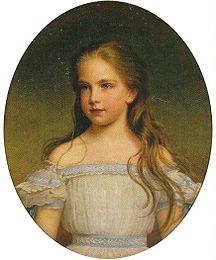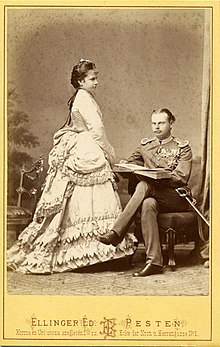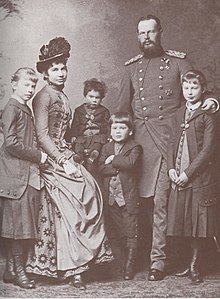Gisela of Austria
Gisel (l) a Louise Marie Archduchess of Austria, Princess of Bavaria , (* July 12, 1856 in Laxenburg , Austria, † July 27, 1932 in Munich ), was a daughter of Emperor Franz Joseph I and Empress Elisabeth .
Life

Gisela was actually christened Gisella , but always wrote her name with an "l". She was the second daughter of Emperor Franz Joseph I and Empress Elisabeth .
Gisela never had a close relationship with her mother, as Empress Elisabeth became the mother of her first daughter Sophie at the age of 17 and gave birth to Gisela the following year. Gisela had a very close relationship with her younger brother, Crown Prince Rudolf . Even after Gisela's marriage and relocation to Bavaria, the siblings stayed in contact. She never got over Rudolf's suicide in her life.
Her mother, who regretted having been married too early, considered a husband for 16-year-old Gisela. She married Prince Leopold of Bavaria , son of Prince Regent Luitpold of Bavaria and Auguste Ferdinande of Austria , her second cousin, on April 20, 1873 in Vienna , and had four children with him. On the occasion of the wedding in Schwabing in 1873, Giselastraße was named after her.
In Bavaria, Gisela was warmly welcomed by Leopold's family. Her father Franz Joseph was a welcome guest in the Leopoldinisches Palais. Her younger sister Marie Valerie was also often visiting. Empress Elisabeth only appeared at the christening of Gisela's first daughter, for whom she was the godmother and namesake. But the empress did not come to the wedding of her own daughter. The mother preferred to stay in a hotel than with her daughter and, what Gisela could not have known, referred to her in her poems as a skinny pig and her children as piglets . After the death of her mother, Gisela inherits 2/5 of the total assets of 10 mil. Gulden and the Achilleion .
Her life was determined by social and church engagement. For example, during the First World War she set up a hospital in her Munich palace. After the collapse, she and her husband had to flee Munich. Also in Bad Ischl , where they arrived with forged passports, they were attacked by the workers 'and soldiers' council and, as aristocratic parasites, they were denied the necessary food.
On April 20, 1923, Gisela and Leopold celebrated their golden wedding. After 57 years of marriage, Leopold died on September 28, 1930. In 1932 Gisela died as the last of the imperial siblings at the age of 76 with her family in Munich. She was buried next to her husband in the Church of St. Michael in Munich.
An Austrian railway line was named after her: the Giselabahn from Salzburg Hauptbahnhof on the one hand and Selzthal on the other to Wörgl Hauptbahnhof via Bischofshofen , Zell am See and Kitzbühel . The Giselabahn (also called Salzburg-Tiroler-Bahn ) forms a section of the Kaiserin-Elisabeth-Bahn (named after Gisela's mother) from Vienna via Linz and Wels to Passau and also via Wels, Salzburg and Zell am See to Wörgl , which in turn again forms a section of the Austrian Western Railway (Vienna - Lindau ). In the city of Wörgl - the end point of the Giselabahn - there is consequently a Giselastraße.
The Giselawarte on the Lichtenberg near Linz was also named after her; construction began in 1856, the year she was born; The observation tower was opened in 1857. In addition, the colloquial name "G sharp" for the Lichtenberg is derived from it. In 1869, at the age of 13, Gisela became protector of the Gisela Association named after her by imperial approval, which existed in Germany until 1981 under the name "Gisela Allgemeine Lebens- und Aussteuer-Versicherungs-AG" (today ARAG Lebensversicherungs-AG ). The paddle steamer Gisela from 1871, which still sails on the Traunsee today, is also named after the emperor's daughter. Furthermore, today's Vörösmarty tér in Budapest carried her name as Giselaplatz from 1874 to 1926, with an interruption after the First World War.
After all, the princess is the namesake of the Gisela-Gymnasium, founded in 1904 as a district secondary school in Munich , in the direct vicinity of the Elisabethmarkt on Elisabethplatz, which in turn is named after Gisela's mother .
personality
Gisela was sober and looked very much like her father. After the early separation from her brother, who had been prepared early on for the role of heir to the throne, she became more and more quiet and devoted herself to the tasks assigned to her with enthusiasm, because it seemed very important to her grandmother that she received lessons in domestic virtues. In addition, she should also be a good rider and hunter, because great importance was attached to this within the family. The obedient child obeyed all of the grandmother's orders. This sense of family was also evident later when she looked after her other grandmother Ludovika , who often and happily visited her.
progeny
- Elisabeth Marie von Bayern (1874–1957) ⚭ 1893 Otto Ludwig Philipp von Seefried on Buttenheim
- Auguste Maria Luise of Bavaria (1875–1964) ⚭ 1893 Joseph August of Austria
- Georg Franz Josef of Bavaria (1880–1943) ⚭ 1912 Isabella of Austria-Teschen
- Konrad Luitpold Franz of Bavaria (1883–1969) ⚭ 1921 Bona Margherita of Savoy-Genoa
literature
- Constantin von Wurzbach : Habsburg, Gisela Louise Maria . In: Biographisches Lexikon des Kaiserthums Oesterreich . 6th part. Kaiserlich-Königliche Hof- und Staatsdruckerei, Vienna 1860, p. 276 ( digitized version ).
- Leopold von Bayern : From the memoirs . Published by Hans-Michael Kröner. Pustet, Regensburg, 1983, ISBN 3-7917-0872-4 .
- Karl Möckl : Gisela, Princess of Bavaria . In: Brigitte Hamann (Ed.): The Habsburgs. A biographical lexicon . Ueberreuter, Vienna 1988, ISBN 3-8000-3247-3 , p. 158 f.
- Friedrich Weissensteiner : Heaven of love and hells of marriage. Weddings between Habsburgs and Wittelsbachers . 2nd Edition. Wilhelm Heyne, Munich 2001, ISBN 3-453-17853-X , ( Heyne Sachbuch 19/736).
- Martha Schad : Empress Elisabeth and her daughters . Unabridged paperback edition in the text. 10th edition. Piper, Munich et al. 2006, ISBN 3-492-22857-7 , ( Piper 2857 series ).
Web links
Individual evidence
- ^ The Habsburgs - Gisela of Austria (1856–1932) on planet-vienna.com
- ↑ Handwritten letter from Archduchess Gisela of Austria
- ^ Hans Dollinger: Die Münchner Straßeennamen, 7th, updated edition, Munich 2010, p. 104.
- ↑ a b Gisela, Archduchess of Austria on habsburger.net
- ↑ Sisi - life and legend of an empress, Vocelka, Michaela & Karl. Retrieved October 31, 2017 .
- ↑ Sigrid-Maria Großering: Sisi and her family . Ueberreuter Verlag, Vienna 2005, ISBN 3-8000-3857-9 , p. 157.
- ↑ Sigrid-Maria Großering: Sisi and her family . Ueberreuter Verlag, Vienna 2005, ISBN 3-8000-3857-9 , p. 136.
- ^ Paddle steamer Gisela - Traunseeschifffahrt
- ↑ Vorosmarty Square (Gisela Square) in Budapest
- ↑ Gisela-Oberrealschule (now Gisela-Gymnasium) at Elisabethplatz in Munich
- ↑ Information about the marriage and descendants of Otto Ludwig Philipp von Seefried on Buttenheim , ahnen.hartenthaler.eu
- ^ Hans Rall, Marga Rall: Die Wittelsbacher in Lebensbildern , Publisher: Pustet, Regensburg; First edition 1986, ISBN 3-791-71035-4
| personal data | |
|---|---|
| SURNAME | Gisela of Austria |
| ALTERNATIVE NAMES | Gisela Louise Marie, Archduchess of Austria |
| BRIEF DESCRIPTION | Archduchess of Austria |
| DATE OF BIRTH | July 12, 1856 |
| PLACE OF BIRTH | Laxenburg , Austria |
| DATE OF DEATH | July 27, 1932 |
| Place of death | Bavaria |



